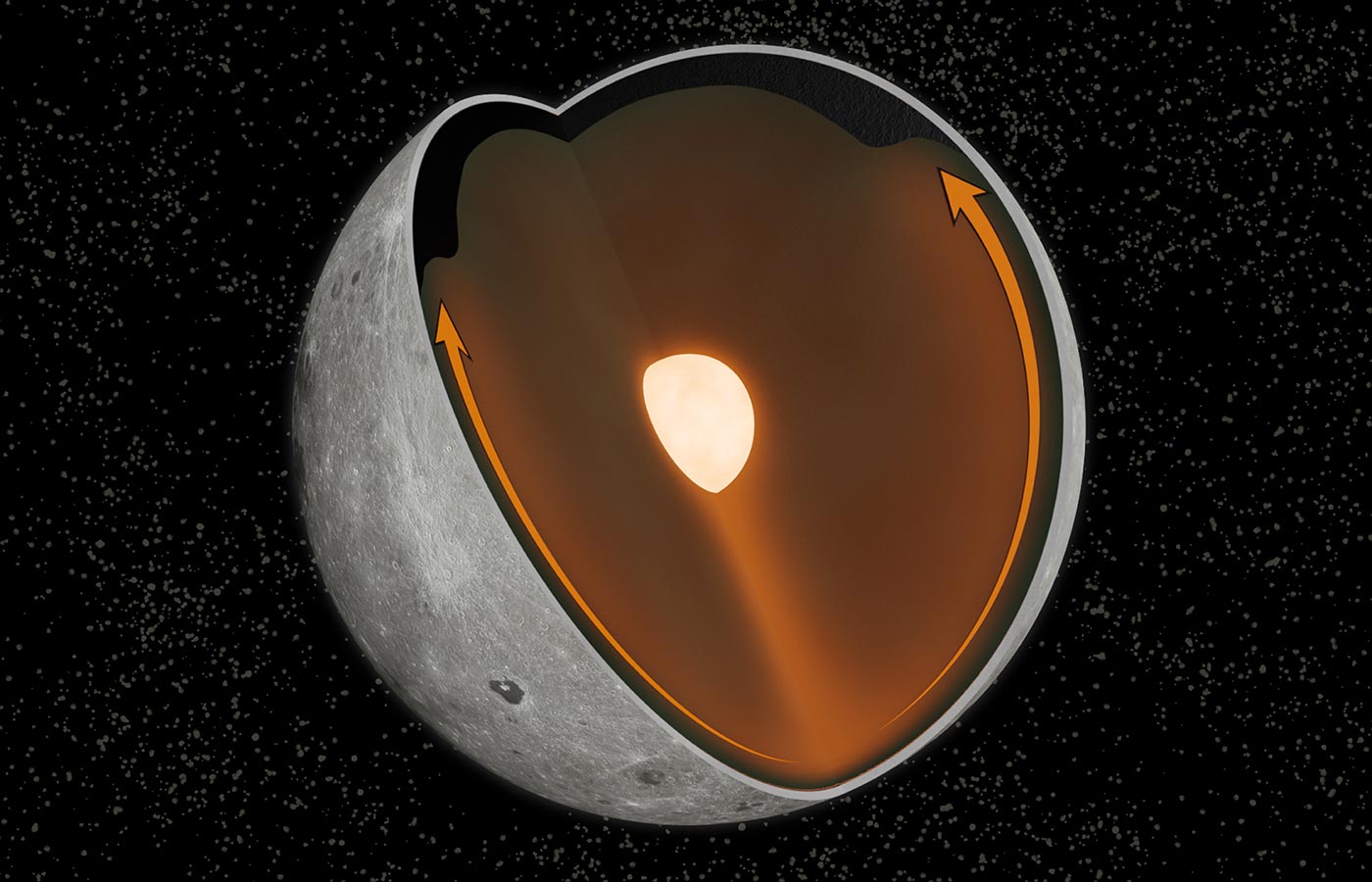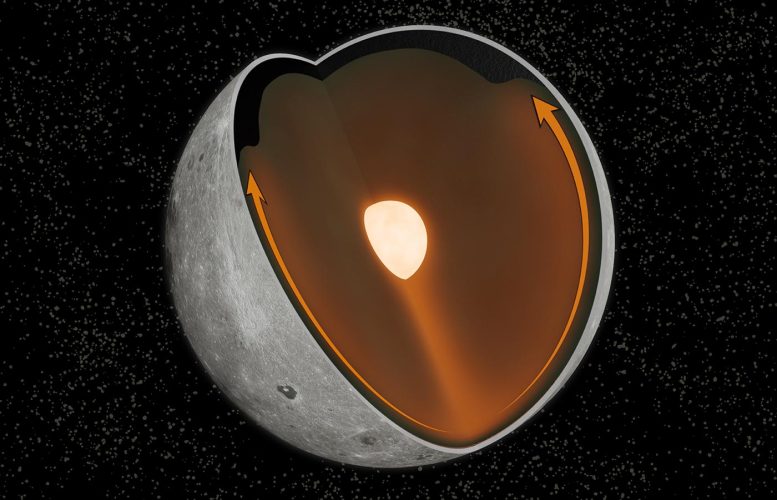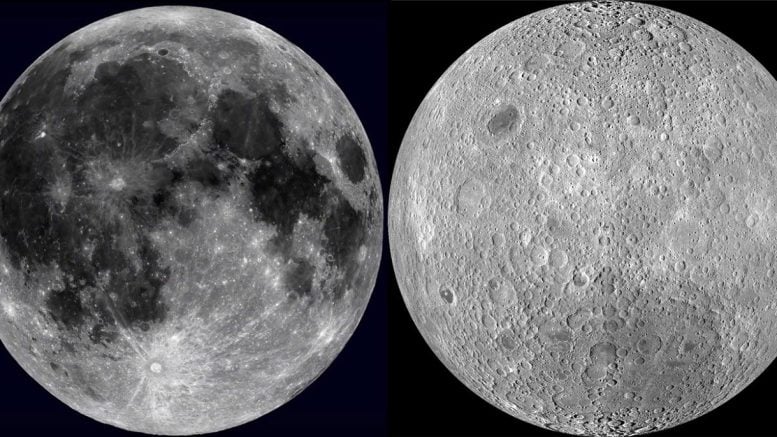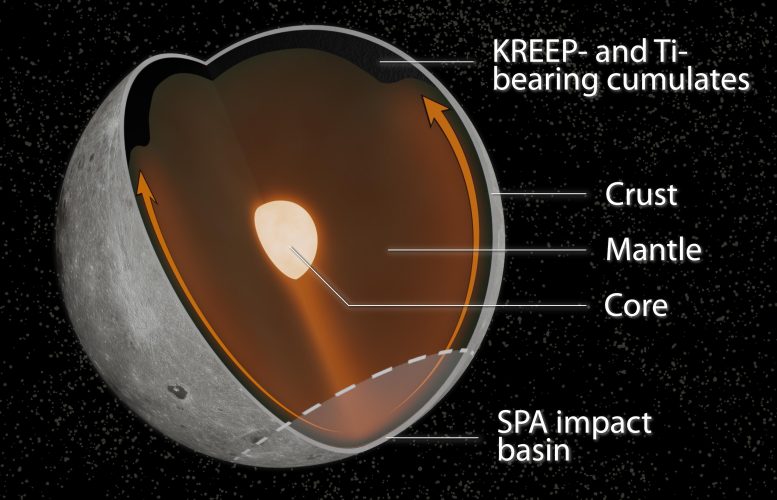

كشفت دراسة جديدة أن تصادمًا قديمًا على القطب الجنوبي للقمر قد غيّر أنماط الحمل الحراري في الوشاح القمري ، مع التركيز على مجموعة من العناصر المنتجة للحرارة على الجانب القريب. لعبت هذه العناصر دورًا في تكوين الفرس القمري الشاسع المرئي من الأرض. الائتمان: مات جونز
يُظهر بحث جديد كيف أن التأثير الذي أحدث القطب الجنوبي – حوض آيتكن للقمر مرتبط بالتباين الصارخ في التركيب والمظهر بين جانبي القمر.
يبدو الوجه الذي يظهره القمر للأرض مختلفًا تمامًا عن الوجه الذي يخفيه على جانبه البعيد. تهيمن الفرس القمرية على الجانب القريب – البقايا الشاسعة ذات اللون الداكن لتدفقات الحمم البركانية القديمة. من ناحية أخرى ، فإن الجانب البعيد المليء بالفوهة يخلو فعليًا من ميزات الفرس واسعة النطاق. سبب الاختلاف الكبير بين الجانبين هو أحد الألغاز الأكثر ديمومة على القمر.
الآن ، لدى الباحثين تفسير جديد للقمر ذي الوجهين – تفسير يتعلق بتأثير عملاق منذ مليارات السنين بالقرب من القطب الجنوبي للقمر.
أظهرت دراسة جديدة نُشرت في مجلة Science Advances أن التأثير الذي شكل حوض القطب الجنوبي العملاق للقمر – أيتكين (SPA) كان من شأنه أن يخلق عمودًا هائلاً من الحرارة ينتشر عبر باطن القمر. كان من الممكن أن يحمل هذا العمود موادًا معينة – مجموعة من العناصر الأرضية النادرة والعناصر المنتجة للحرارة – إلى جانب القمر القريب. كان من الممكن أن يساهم تركيز العناصر هذا في النشاط البركاني الذي أدى إلى إنشاء السهول البركانية القريبة.

تهيمن الرواسب البركانية الواسعة على الجانب القريب من القمر (على اليسار) ، بينما يحتوي الجانب البعيد (الأيمن) على عدد أقل بكثير). سبب الاختلاف الكبير بين الجانبين هو لغز قمر دائم. الائتمان: جامعة براون
قال مات جونز ، دكتوراه: “نحن نعلم أن التأثيرات الكبيرة مثل تلك التي شكلت SPA ستخلق الكثير من الحرارة”. مرشح في جامعة براون والمؤلف الرئيسي للدراسة. السؤال هو كيف تؤثر هذه الحرارة على الديناميكيات الداخلية للقمر. ما نظهره هو أنه في ظل أي ظروف معقولة في الوقت الذي تشكل فيه SPA ، ينتهي به الأمر بتركيز هذه العناصر المنتجة للحرارة على الجانب القريب. نتوقع أن هذا ساهم في ذوبان الوشاح الذي أدى إلى تدفقات الحمم البركانية التي نراها على السطح. “
كانت الدراسة تعاونًا بين جونز ومستشاره ألكسندر إيفانز ، الأستاذ المساعد في جامعة براون ، جنبًا إلى جنب مع باحثين من جامعة بوردو ومختبر علوم القمر والكواكب في أريزونا وجامعة ستانفورد و[{” attribute=””>NASA’s Jet Propulsion Laboratory.

A new study reveals that an ancient collision on the Moon’s south pole changed patterns of convection in the lunar mantle, concentrating a suite of heat-producing elements on the nearside. Those elements played a role in creating the vast lunar mare visible from Earth. Credit: Matt Jones
The differences between the near and far sides of the Moon were first revealed in the 1960s by the Soviet Luna missions and the U.S. Apollo program. While the differences in volcanic deposits are plain to see, future missions would reveal differences in the geochemical composition as well. The nearside is home to a compositional anomaly known as the Procellarum KREEP terrane (PKT) — a concentration of potassium (K), rare earth elements (REE), phosphorus (P), along with heat-producing elements like thorium. KREEP seems to be concentrated in and around Oceanus Procellarum, the largest of the nearside volcanic plains, but is sparse elsewhere on the Moon.
Some scientists have suspected a connection between the PKT and the nearside lava flows, but the question of why that suite of elements was concentrated on the nearside remained. This new study provides an explanation that is connected to the South Pole–Aitken basin, the second largest known impact crater in the solar system.
For the study, the researchers conducted computer simulations of how heat generated by a giant impact would alter patterns of convection in the Moon’s interior, and how that might redistribute KREEP material in the lunar mantle. KREEP is thought to represent the last part of the mantle to solidify after the Moon’s formation. As such, it likely formed the outermost layer of mantle, just beneath the lunar crust. Models of the lunar interior suggest that it should have been more or less evenly distributed beneath the surface. But this new model shows that the uniform distribution would be disrupted by the heat plume from the SPA impact.
According to the model, the KREEP material would have ridden the wave of heat emanating from the SPA impact zone like a surfer. As the heat plume spread beneath the Moon’s crust, that material was eventually delivered en masse to the nearside. The team ran simulations for a number of different impact scenarios, from dead-on hit to a glancing blow. While each produced differing heat patterns and mobilized KREEP to varying degrees, all created KREEP concentrations on the nearside, consistent with the PKT anomaly.
The researchers say the work provides a credible explanation for one of the Moon’s most enduring mysteries.
“How the PKT formed is arguably the most significant open question in lunar science,” Jones said. “And the South Pole–Aitken impact is one of the most significant events in lunar history. This work brings those two things together, and I think our results are really exciting.”
Refernece: “A South Pole–Aitken impact origin of the lunar compositional asymmetry” by Matt J. Jones, Alexander J. Evans, Brandon C. Johnson, Matthew B. Weller, Jeffrey C. Andrews-Hanna, Sonia M. Tikoo and James T. Kean, 8 April 2022, Science Advances.
DOI: 10.1126/sciadv.abm8475

“هواة الإنترنت المتواضعين بشكل يثير الغضب. مثيري الشغب فخور. عاشق الويب. رجل أعمال. محامي الموسيقى الحائز على جوائز.”
